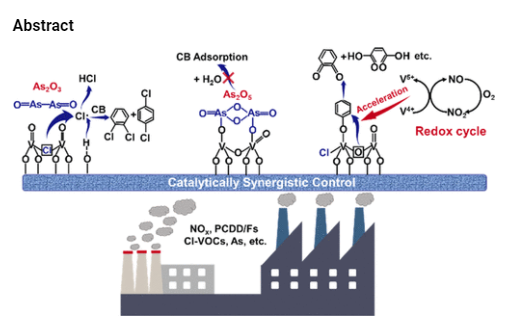博文
【浙大翁小乐】NOx-二噁英在VWT催化剂上的协同净化,As的影响
||
https://pubs.acs.org/doi/10.1021/acs.est.1c02636
目前污染物的协同处理是学术研究、实际应用的热点方向,尤其是焚烧行业中NOx和二噁英(这两个污染物在工业焚烧相关行业不可避免都会产生)的协同净化尤为“实用”
但在垃圾焚烧等过程中都会存在As等重金属、碱金属,造成催化剂中毒

Municipal solid waste incineration and the iron and steel smelting industry can simultaneously discharge NOx and chlorinated organics, particularly polychlorinated dibenzo-p-dioxins and polychlorinated dibenzofurans (PCDD/Fs). Synergistic control of these pollutants has been considered among the most cost-effective methods. This work combined experimental and computational methods to investigate the reaction characteristics of a catalytically synergistic approach and gives the first insight into the effect of arsenic (As) on the multipollutant conversion efficiency, synergistic reaction mechanism, and toxic byproduct distribution over a commercial V2O5–WO3/TiO2 catalyst. The loaded As2O3 species were shown to distinctly decrease the formation energy of an oxygen vacancy at the V–O–V site, which likely contributed to the extensive formation of more toxic polychlorinated byproducts in the synergistic reaction. The As2O5 species strongly attacked neighboring V═O sites forming the As–O–V bands. Such an interaction deactivated the deNOx reaction, but led to excessive NO being oxidized into NO2 that greatly promoted the V5+–V4+ redox cycle and in turn facilitated chlorobenzene (CB) oxidation. Subsequent density functional theory (DFT) calculation further reveals that both the As2O3 and As2O5 loadings can facilitate H2O adsorption on the V2O5–WO3/TiO2 catalyst, leading to competitive adsorption between H2O and CB, and thereby deactivate the CB oxidation with water stream.


Figure 1. Catalytic activities and mineralization rates of (a) VWT, (b) 0.05 wt % As/VWT, (c) 0.2 wt % As/VWT, and (d) 0.5 wt % As/VWT catalysts in the synergistic reaction. Reaction conditions: 600 ppm NO, 600 ppm NH3, 100 ppm CB, 5 vol % O2, N2 balance, and GHSV = 40,000 h–1.
https://blog.sciencenet.cn/blog-3913-1290986.html
上一篇:【华科大郭利民】水滑石LDHs衍生Co-Cr双金属氧化物上氯代芳烃的催化燃烧,酸性位-氧化中心协同
下一篇:【天大林法伟】MnO2上CVOCs的臭氧氧化,低温、高效、高选择性、高稳定性